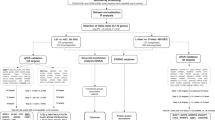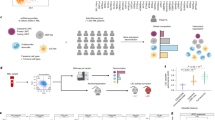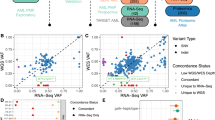Abstract
Bone marrow samples from 43 adult patients with de novo diagnosed acute myeloid leukemia (AML) – 10 acute promyelocytic leukemias (APL) with t(15;17), four AML with inv(16), seven monocytic leukemias and 22 nonmonocytic leukemias – were analyzed using high-density oligonucleotide microarrays. Hierarchical clustering analysis segregated APL, AML with inv(16), monocytic leukemias and the remaining AML into separate groups. A set of only 21 genes was able to assign AML to one of these three classes: APL, inv(16) and other AML subtype without a specific translocation. Quantitative RT-PCR performed for 18 out of these predictor genes confirmed microarray results. APL expressed high levels of FGF13 and FGFR1 as well as two potent angiogenic factors, HGF and VEGF. AML with inv(16) showed an upregulation of MYH11 and a downregulation of a gene encoding a core-binding factor protein, RUNX3. Genes involved in cell adhesion represented the most altered functional category in monocytic leukemias. Two major groups emerged from the remaining 22 AML: cluster A with 10 samples and cluster B with 12. All the eight leukemias that were either refractory to treatment or that relapsed afterwards were assigned to cluster B. In the latter cluster, CD34 upregulation and serine proteases downregulation is consistent with a maturation arrest and lack of granulocytic differentiation.
This is a preview of subscription content, access via your institution
Access options
Subscribe to this journal
Receive 12 print issues and online access
$259.00 per year
only $21.58 per issue
Buy this article
- Purchase on Springer Link
- Instant access to full article PDF
Prices may be subject to local taxes which are calculated during checkout


Similar content being viewed by others
References
Vardiman JW, Harris NL, Brunning RD . The World Health Organization (WHO) classification of the myeloid neoplasms. Blood 2002; 100: 2292–2302.
Grimwade D, Walker H, Oliver F, Wheatley K, Harrison C, Harrison G et al. The importance of diagnostic cytogenetics on outcome in AML: analysis of 1,612 patients entered into the MRC AML 10 trial. The Medical Research Council Adult and Children's Leukaemia Working Parties. Blood 1998; 92: 2322–2333.
Slovak ML, Kopecky KJ, Cassileth PA, Harrington DH, Theil KS, Mohamed A et al. Karyotypic analysis predicts outcome of preremission and postremission therapy in adult acute myeloid leukemia: a Southwest Oncology Group/Eastern Cooperative Oncology Group Study. Blood 2000; 96: 4075–4083.
Golub TR, Slonim DK, Tamayo P, Huard C, Gaasenbeek M, Mesirov JP et al. Molecular classification of cancer: class discovery and class prediction by gene expression monitoring. Science 1999; 286: 531–537.
Schoch C, Kohlmann A, Schnittger S, Brors B, Dugas M, Mergenthaler S et al. Acute myeloid leukemias with reciprocal rearrangements can be distinguished by specific gene expression profiles. Proc Natl Acad Sci USA 2002; 99: 10008–10013.
Debernardi S, Lillington DM, Chaplin T, Tomlinson S, Amess J, Rohatiner A et al. Genome-wide analysis of acute myeloid leukemia with normal karyotype reveals a unique pattern of homeobox gene expression distinct from those with translocation-mediated fusion events. Genes Chromosomes Cancer 2003; 37: 149–158.
Kohlmann A, Schoch C, Schnittger S, Dugas M, Hiddemann W, Kern W et al. Molecular characterization of acute leukemias by use of microarray technology. Genes Chromosomes Cancer 2003; 37: 396–405.
Valk PJ, Verhaak RG, Beijen MA, Erpelinck CA, van Waalwijk van Doorn-Khosrovani SB, Boer JM et al. Prognostically useful gene-expression profiles in acute myeloid leukemia. N Engl J Med 2004; 350: 1617–1628.
Bullinger L, Dohner K, Bair E, Frohling S, Schlenk RF, Tibshirani R et al. Use of gene-expression profiling to identify prognostic subclasses in adult acute myeloid leukemia. N Engl J Med 2004; 350: 1605–1616.
Armstrong SA, Staunton JE, Silverman LB, Pieters R, Den Boer ML, Minden MD et al. MLL translocations specify a distinct gene expression profile that distinguishes a unique leukemia. Nat Genet 2002; 30: 41–47.
Virtaneva K, Wright FA, Tanner SM, Yuan B, Lemon WJ, Caligiuri MA et al. Expression profiling reveals fundamental biological differences in acute myeloid leukemia with isolated trisomy 8 and normal cytogenetics. Proc Natl Acad Sci USA 2001; 98: 1124–1129.
Qian Z, Fernald AA, Godley LA, Larson RA, Le Beau MM . Expression profiling of CD34+ hematopoietic stem/progenitor cells reveals distinct subtypes of therapy-related acute myeloid leukemia. Proc Natl Acad Sci USA 2002; 99: 14925–14930.
Staal FJ, van der Burg M, Wessels LF, Barendregt BH, Baert MR, van den Burg CM et al. DNA microarrays for comparison of gene expression profiles between diagnosis and relapse in precursor-B acute lymphoblastic leukemia: choice of technique and purification influence the identification of potential diagnostic markers. Leukemia 2003; 17: 1324–1332.
Chillón MC, Fernández C, García-Sanz R, Balanzategui A, Ramos F, Fernández-Calvo J et al. FLT3-activating mutations are associated with poor prognostic features in AML at diagnosis but they are not an independent prognostic factor. Hematol J 2004; 5: 239–246.
Sanz MA, Martín G, Rayón C, Esteve J, González M, Díaz-Mediavilla J et al. A modified AIDA protocol with anthracycline-based consolidation results in high antileukemic efficacy and reduced toxicity in newly diagnosed PML/RARalpha-positive acute promyelocytic leukemia. PETHEMA group. Blood 1999; 94: 3015–3021.
Eisen MB, Spellman PT, Brown PO, Botstein D . Cluster analysis and display of genome-wide expression patterns. Proc Natl Acad Sci USA 1998; 95: 14863–14868.
Borg I, Groenen PM . Modern Multidimensional Scaling: Theory and Applications. New York: Springer Verlag, 1997.
Tusher VG, Tibshirani R, Chu G . Significance analysis of microarrays applied to the ionizing radiation response. Proc Natl Acad Sci USA 2001; 98: 5116–5121.
Tibshirani R, Hastie T, Narasimhan B, Chu G . Diagnosis of multiple cancer types by shrunken centroids of gene expression. Proc Natl Acad Sci USA 2002; 99: 6567–6572.
Furey TS, Cristianini N, Duffy N, Bednarski DW, Schummer M, Haussler D . Support vector machine classification and validation of cancer tissue samples using microarray expression data. Bioinformatics 2000; 16: 906–914.
Ririe KM, Rasmussen RP, Wittwer CT . Product differentiation by analysis of DNA melting curves during the polymerase chain reaction. Anal Biochem 1997; 245: 154–160.
Leung KH, Pippalla V, Kreutter A, Chandler M . Functional effects of FGF-13 on human lung fibroblasts, dermal microvascular endothelial cells, and aortic smooth muscle cells. Biochem Biophys Res Commun 1998; 250: 137–142.
Inhorn RC, Aster JC, Roach SA, Slapak CA, Soiffer R, Tantravahi R et al. A syndrome of lymphoblastic lymphoma, eosinophilia, and myeloid hyperplasia/malignancy associated with t(8;13)(p11;q11): description of a distinctive clinicopathologic entity. Blood 1995; 85: 1881–1887.
Macdonald D, Reiter A, Cross NC . The 8p11 myeloproliferative syndrome: a distinct clinical entity caused by constitutive activation of FGFR1. Acta Haematol 2002; 107: 101–107.
Cross NC, Reiter A . Tyrosine kinase fusion genes in chronic myeloproliferative diseases. Leukemia 2002; 16: 1207–1212.
Jiang W, Hiscox S, Matsumoto K, Nakamura T . Hepatocyte growth factor/scatter factor, its molecular, cellular and clinical implications in cancer. Crit Rev Oncol Hematol 1999; 29: 209–248.
Verstovsek S, Kantarjian H, Estey E, Aguayo A, Giles FJ, Manshouri T et al. Plasma hepatocyte growth factor is a prognostic factor in patients with acute myeloid leukemia but not in patients with myelodysplastic syndrome. Leukemia 2001; 15: 1165–1170.
Kini AR, Peterson LA, Tallman MS, Lingen MW . Angiogenesis in acute promyelocytic leukemia: induction by vascular endothelial growth factor and inhibition by all-trans retinoic acid. Blood 2001; 97: 3919–3924.
Moehler TM, Ho AD, Goldschmidt H, Barlogie B . Angiogenesis in hematologic malignancies. Crit Rev Oncol Hematol 2003; 45: 227–244.
Giles FJ, Stopeck AT, Silverman LR, Lancet JE, Cooper MA, Hannah AL et al. SU5416, a small molecule tyrosine kinase receptor inhibitor, has biologic activity in patients with refractory acute myeloid leukemia or myelodysplastic syndromes. Blood 2003; 102: 795–801.
Drabkin HA, Parsy C, Ferguson K, Guilhot F, Lacotte L, Roy L et al. Quantitative HOX expression in chromosomally defined subsets of acute myelogenous leukemia. Leukemia 2002; 16: 186–195.
Owens BM, Hawley RG . HOX and non-HOX omeobox genes in leukemic hematopoiesis. Stem Cells 2002; 20: 364–379.
Thorsteinsdottir U, Kroon E, Jerome L, Blasi F, Sauvageau G . Defining roles for HOX and MEIS1 genes in induction of acute myeloid leukemia. Mol Cell Biol 2001; 21: 224–234.
Kawagoe H, Kawagoe R, Sano K . Targeted down-regulation of MLL-AF9 with antisense oligodeoxyribonucleotide reduces the expression of the HOXA7 and -A10 genes and induces apoptosis in a human leukemia cell line, THP-1. Leukemia 2001; 15: 1743–1749.
Hernández JM, Martín G, Gutiérrez NC, Cervera J, Ferro MT, Calasanz MJ et al. Additional cytogenetic changes do not influence the outcome of patients with newly diagnosed acute promyelocytic leukemia treated with an ATRA plus anthracyclin based protocol. A report of the Spanish group PETHEMA. Haematologica 2001; 86: 807–813.
van der Reijden BA, Lombardo M, Dauwerse HG, Giles RH, Muhlematter D, Bellomo MJ et al. RT-PCR diagnosis of patients with acute nonlymphocytic leukemia and inv(16)(p13q22) and identification of new alternative splicing in CBFB-MYH11 transcripts. Blood 1995; 86: 277–282.
Cleveland DW, Yen TJ . Multiple determinants of eukaryotic mRNA stability. New Biol 1989; 1: 121–126.
van der Reijden BA, Massop M, Tonnissen E, van de Locht L, Muus P, De Witte T et al. Rapid identification of CBFB-MYH11-positive acute myeloid leukemia (AML) cases by one single MYH11 real-time RT-PCR. Blood 2003; 101: 5085–5086.
Li QL, Ito K, Sakakura C, Fukamachi H, Inoue K, Chi XZ et al. Causal relationship between the loss of RUNX3 expression and gastric cancer. Cell 2002; 109: 113–124.
Lutz PG, Houzel-Charavel A, Moog-Lutz C, Cayre YE . Myeloblastin is an Myb target gene: mechanisms of regulation in myeloid leukemia cells growth-arrested by retinoic acid. Blood 2001; 97: 2449–2456.
Acknowledgements
We thank Mark Anderson of the University Technology Transfer Office and M Ángeles Hernández, Amador Crego, Ana Simón, Laura Hierro and Estela Hernández for technical assistance. We are grateful to Fenghuang Zhan and John Shaughnessy for technical support on microarray analysis. This study was partially supported by ‘Ministerio de Ciencia y Tecnología’ Grant (SAF2001-1687) and Spanish FIS Grant (02/1358). NCG, RLP and JLG were partially supported by grants from ‘Fundación Española de Hematología y Hemoterapia’, ‘Asociación Española contra el Cáncer’ and Spanish FIS (01/3153), respectively.
Author information
Authors and Affiliations
Corresponding author
Additional information
Supplementary Information
Supplementary Information accompanies the paper on the Leukemia website (http://www.nature.com/leu)
Supplementary information
Rights and permissions
About this article
Cite this article
Gutiérrez, N., López-Pérez, R., Hernández, J. et al. Gene expression profile reveals deregulation of genes with relevant functions in the different subclasses of acute myeloid leukemia. Leukemia 19, 402–409 (2005). https://doi.org/10.1038/sj.leu.2403625
Received:
Accepted:
Published:
Issue Date:
DOI: https://doi.org/10.1038/sj.leu.2403625



